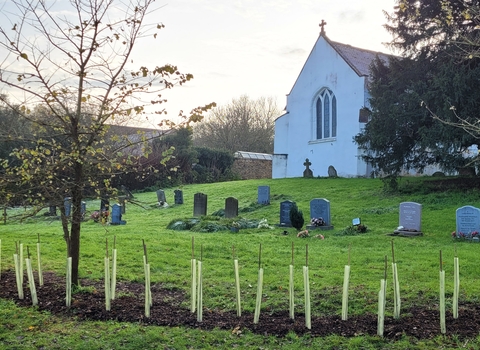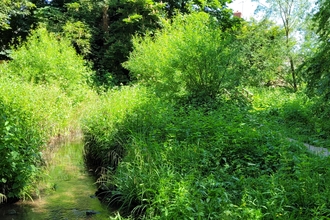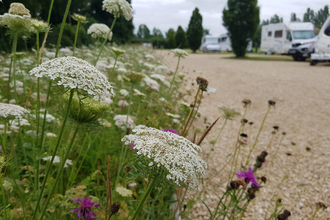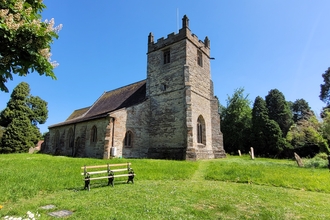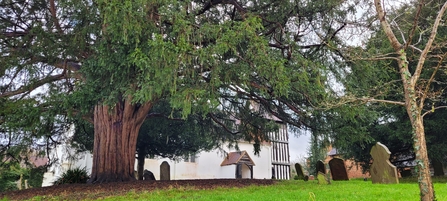
Yew tree at St Nicholas' Church by Becca Bratt
Hidden away in a pretty corner of Warndon lies St Nicholas’ Church; a Grade 1 listed building, parts of which date back to the early 12th Century.
The tower was constructed in 1542 and is made from oak timbers with lathe and plaster infill and contains 3 bells. Bats are known to roost in the tower and are often seen emerging as they head out to find food at dusk.
Within the churchyard stand two large, impressive yew trees, thought to be the oldest in the county and with significant value ecologically and historically. The church holds the Eco Church Bronze Award for the changes it has made to lessen its impact on the environment and, with the help of Natural Networks, was keen to push this work further by enhancing the habitats in and around the churchyard.
The project involved a range of interventions to boost biodiversity on site, as well as enhancing people’s enjoyment of the space. The first job was to remove the old, defunct metal railing around the churchyard’s perimeter and replace it with a native hedgerow. Over 40 metres of new hedgerow have been planted featuring 9 different native species, protected by biodegradable guards and canes. As this matures, it will provide fruits, berries and nesting habitat as well as a corridor for wildlife to move across the site and will act as a screen between the graveyard and the car park.
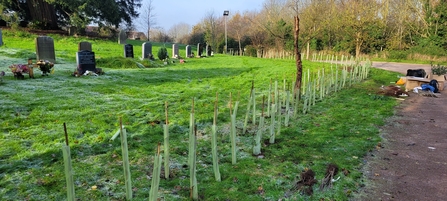
Newly planted hedgerow at St. Nicholas' Church by Becca Bratt
Spring flowering plants, such as English bluebell, snowdrops, primroses and greater stitchwort, have been planted beneath the tree canopies and along the main track to greet visitors with a flush of colour. Plants that attract night flying moths by producing scent after dark are now in position alongside the barn to increase insect numbers and give the resident bats a source of food. Shade-lovers, such as wood avens, nettle-leaved bellflower, hedge bedstraw and wood sage, have been planted to diversify flora under the tree canopies. The north facing bank has been planted up with native ferns to add further habitat diversity.
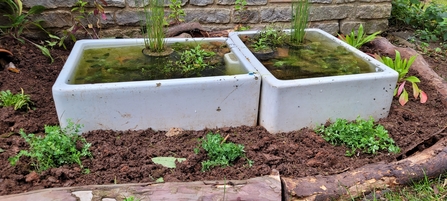
Mini ponds installed at St. Nicholas' Church by Becca Bratt
Two mini ponds have been installed and planted up with a range of native pond plants, such as hornwort and water forget-me-not, and log piles and stones provide a means of entry and exit for wildlife. Amphibians such as frogs, toads and newts are known to be in the immediate area so the addition of water to a site, no matter how small, is always beneficial to wildlife. Several bird boxes have also been installed on trees around the perimeter to boost nesting opportunities for small birds.
The area of grassland near the entrance is now being managed as a mini hay meadow by relaxing the mowing regime. The grass will now be cut and collected once a year, at the end of summer. This will encourage the wild plants to flower, set seed and provide resources for insects, birds and small mammals, further enhancing the backdrop to this wonderful little church.
Peter Vickery, member of the Church council and main organiser of St Nicholas’ Church Natural Networks project, commented "“I found our Natural Networks project to be a thoroughly worthwhile undertaking. It involved investing some time and work but it has already improved the appearance and biodiversity of our churchyard and that is only going to get better. I found the wildlife officers and the council grant team to be extremely approachable and helpful. I have no hesitation in recommending contacting the Natural Networks team to anyone who thinks that they might undertake such a project.”


